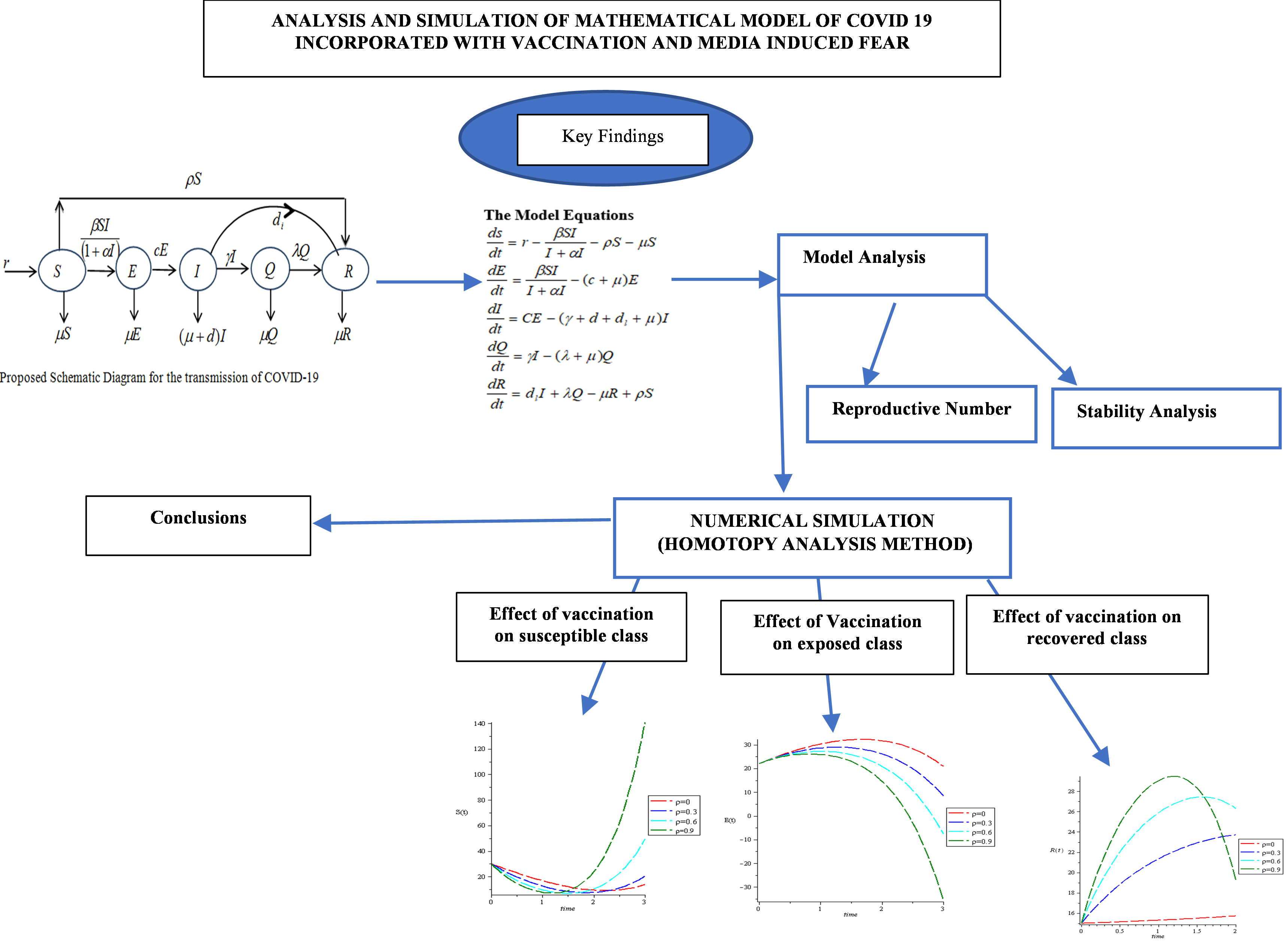Analysis and Simulation of Mathematical Model of COVID-19 Incorporated with Vaccination and Media Induced Fear
DOI:
https://doi.org/10.48048/tis.2023.4600Keywords:
COVID-19, Vaccination, Disease free equilibrium, Endemic equilibrium, Homotopy, Perturbation methodAbstract
COVID-19 pandemic is now increasing concern to authorities and public health officials. The study is aimed to investigate the impact of vaccination in the absence of media induced fear. In this research, analysis and simulation of a mathematical model of COVID-19 incorporated with media induced fear and vaccination was made, the total population is divided into 5 sub-population classes; Susceptible, Exposed, Infected, Quarantine and Recovery. The disease free and the endemic equilibrium of the model were carried out and the basic reproduction number was obtained using the next generation matrix. The stability analysis of the model was done and it was ascertained that the disease free equilibrium of the biological model is stable. Due to its efficiency and accuracy in handling nonlinear coupled ordinary differential equations, the homotopy perturbation method is applied to obtain the approximate solution of the mathematical model and the obtained results was simulated using the computation software Maple 18 to study the impact of vaccination in each compartment of the model when the media induced fear. The outcome of the simulation process were presented graphically and interpreted accordingly and it was discovered that in eradicating the spread of COVID-19 in a society where there is no fear, vaccination is an alternative and better measure.
HIGHLIGHTS
- Model formulation with vaccination
- Stability analysis of the disease free equilibrium and endemic equilibrium
- Numerical simulation of the mathematical model using the homotopy perturbation method
- Analysis of the impact of vaccination in controlling the spread of COVID-19 in the absence of media induced fear
GRAPHICAL ABSTRACT
Downloads
Metrics
References
OM Ogunlaran and SCO Noutchie. Mathematical model for an effective management of HIV infection. BioMed Res. Int. 2016; 2016, 4217548.
MO Olayiwola and MK Kolawole. Some results on the simulation of SEIRS epidemic model with saturated incidence rate for considering the saturation term for susceptible individual. Ann. Comput. Sci. Ser. 2017; 15, 9-18.
JH He. Homotopy perturbation technique. Comput. Methods Appl. Mech. Eng. 1999; 178, 257-62.
JH He. Variational iteration method - a kind of non-linear analytical technique. Int. J. Non-linear Mech. 1999; 34, 699-708.
MO Olayiwola, MK Kolawole and AO Popoola. Variational iteration method for the simulation of the effect of transmission coefficient on the susceptible-exposed-infected-recovered-susceptible (SEIRS) epidemic model with saturated incidence rate. J. Sci. Arts 2017; 17, 357-64.
MK Kolawole and MO Olayiwola. On the numerical simulation of the effect of saturation term on the susceptible individual in Susceptible-Exposed Infected-Recovered-Susceptible (SEIRS) epidemic model. Comput. Inf. Syst. Dev. Inf. Allied Res. J. 2016; 7, 83.
S Balamuralitharan and S Geethamalini. Solutions of epidemic of EIAV infection by HPM. J. Phys.: Conf. Ser. 2018; 1000, 12023.
M Farman, MU Saleem, A Ahmad and MO Ahmad. Analysis and numerical simulation of SEIR epidemic model of measles with a non-integer time fractional derivative using the Laplace Adomian decomposition method. Ain Shams Eng. J. 2018; 9, 3391-7.
H Fazal, S Kamal, R Ghausur and S Muhammad. Numerical solution of fractional order smoking model via laplace Adomian decomposition method. Alex. Eng. J. 2018; 57, 1061-9.
G Adomian. A review of the decomposition method and some recent results for nonlinear equations. Comput. Math. Appl. 1991; 21, 101-27.
C Maji. Impact of media induced fear on the control on covid-19 outbreak: A mathematical study. Int. J. Differ. Equ. 2021; 2021, 2129490.
B Ivorra and AM Ramos. Application of the Be-CoDis mathematical model to forecast the international spread of the 2019-20 Wuhan coronavirus outbreak. Complutense Univ. Madrid 2020. http://dx.doi.org/10.13140/RG.2.2.31460.94081
JKK Asamoah, Z Jin, GQ Sun, B Seidu, E Yankson, A Abidemi, FT Oduro, SE Moore and E Okyere. Sensitivity assessment and optimal economic evaluation of a new COVID-19 compartmental epidemic model with control interventions. Chaos Solitons Fractals 2021; 146, 110885.
JKK Asamoah, MA Owusu, Z Jin, FT Oduro, A Abidemi and EO Gyasi. Global stability and cost-effectiveness analysis of COVID-19 considering the impact of the environment: Using data from Ghana. Chaos Solitons Fractals 2020; 140, 110103.
KA Bashiru, AO Fasoranbaku, O Adebimpe and TA Ojurongbe. Stability analysis of Mother - to - Child Transmission of HIV/AIDS Dynamic Model with Treatment. Annal. Comput. Sci. Series J. 2017; 15, 89-93.
MS Abdo, K Shah, HA Wahash and SK Pancha. On a comprehensive model of the novel coronavirus (COVID-19) under Mittag-Leffler derivative. Chaos Solutions Fractals 2020; 135, 109867.
MAA Al-Qaness, AA Ewees, H Fan, A Aziz and MAE Aziz. Optimization method for forecasting confirmed cases of COVID-19 in China. J. Clin. Med. 2020; 9, 674.
Worldometer, Available at: https://www.worldometers.info, accessed March 2022.
World Population Review, Available at: https://worldpopulationreview.com, accessed March 2022.

Downloads
Published
How to Cite
Issue
Section
License
Copyright (c) 2022 Walailak University

This work is licensed under a Creative Commons Attribution-NonCommercial-NoDerivatives 4.0 International License.






